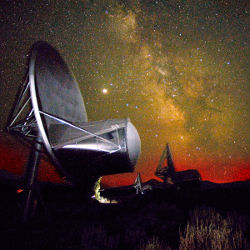
When that first alien broadcast came in—no more than a thin stream of bits, really—it was just about the biggest news story ever.
It was also no surprise. For years, scientists had assured themselves, and every documentary TV maker who asked, that tuning in E.T. would be the greatest discovery ever. If researchers finally found proof of other intelligence lurking in our Milky Way galaxy, they would be shoo-ins for a Nobel Prize. More than that, the discovery would also—somehow—change everything.
Well, everything did change, on a scale far larger than predicted. However, it was because of the second signal, not the first…
The initial signal, picked up in a routine survey of red dwarf star systems by SETI, the Search for Extraterrestrial Intelligence, was only a short, radio ping from the direction of Cassiopeia. The code frame was roughly a minute long and repeated as long as the antennas continued to stare. The frame contained several kilobits of code, arranged in a pictorial matrix, clearly marking it as a deliberate effort to get our attention. Whatever brainpower authored the broadcast was succinct, sending the equivalent of a business card laced with a few astronomical facts about the aliens’ home star system and planet. Earthly pundits argued the senders were likely establishing a data link before inundating us with zetabytes of information, possibly revealing some great truths about the universe.
That seemed reasonable. But everyone was surprised how close the transmitter was, a fact that made the data link feasible. Before the discovery, estimates of the number of technical civilizations in the galaxy ranged from thousands to millions. If true, societies should be separated by at least many hundreds of light-years, on average. But observations with antenna arrays indicated the source of the Cassiopeia transmission was a star system only 16 light-years away. Next door, really. SETI scientists admitted that inhabited worlds could be more commonplace than once believed. Another suggestion was we were, by chance, in an urbanized sector of the galaxy.
The short distance prompted a clamor for a reply, to tell these neighbors they were heard and we were here. Nearly everyone wanted to know more about the aliens: Did they have religion or music? How had they managed to ensure their own long-term survival?
Nearly everyone wanted to know more about the aliens: Did they have religion or music? How had they managed to ensure their long-term survival?
But many people were wary of betraying our existence with a reply. International organizations assembled teams of the Earth’s best and brightest, charging them with making our response sunny, informative, and, especially, non-threatening. This was an agonizing and protracted task. However, scores of top-flight academic researchers schooled in sociology, psychology, and even risk assessment put together a modern New England Primer, a condensed letter of introduction from humans to aliens, finally launching it skyward from the Arecibo antenna three years later. It was repeated 100 times, in case the aliens at the other end missed the beginning of the transmission.
The earthly public hunkered down in anticipation of a response. We were not alone. We were not a miracle. We were simply another bit of intelligence in a cosmos that was vast and old, and there was comfort in the thought we might learn from one another.
Surprisingly, and less than a month later, a second signal was detected, this time from a star system in the direction of Pegasus. SETI scientists had apparently stumbled on the cosmic "hailing frequency," and suddenly alien societies were turning up like crabgrass. The new transmission also contained an endlessly repeated message… a warning…
"Do not respond to the other [Cassiopeia] broadcast!"
Analysts pondered how the senders could know of the first transmission, and why they were telling us not to answer. Contact had produced a disturbing mystery.
Because the new signal was pictorial and highly redundant, its complete contents were relatively easy to decipher. Apparently many thousands of years ago, inhabitants of this second world had picked up the Cassiopeia broadcast. They too had replied, hoping to establish some rudimentary interspecies communication. But they also quickly uncovered a painfully unwelcome fact: The transmission was a ruse, a Trojan horse, emitted to serve the ends of some group whose description could be translated only as "galactic traders." They had long ago developed a strategy to tempt these societies to betray their presence.
Many reverted to primitive behavior, ranging from the hedonistic to the monastic, while others frantically pondered a fix.
Those that did—any responding world—were soon targeted by massive photonic weapons, enormous infrared lasers that could boil off a planet’s atmosphere and incinerate much of its landmass.
Some people immediately questioned whether this second transmission was itself a hoax. But the Pegasus message explicitly said there was no point in any response to them. They were long gone. In their death throes, they had constructed a beacon to warn others.
Our situation was as plain as it was demoralizing. The caution from Pegasus was too late, and our unwitting invitation to earthly destruction was indeed en route at the speed of light.
Humanity seemed destined to stew and fret for the next 32 years, the time required for our transmission to reach them and their photon beam to travel to Earth. In our enthusiasm and endless curiosity we had lit a fuse, and it was now just a matter of waiting out the consequences. The people of Earth lamented that their children would have no grown children of their own. For those who cared about such things, it seemed possible that Homo sapiens‘ greatest discovery would also be its last.
Many reverted to primitive behavior, ranging from the hedonistic to the monastic; others frantically pondered a fix. Given 32 years, there might be time to evacuate at least a few thousand people to some hastily built orbiting space stations or perhaps a base on the Moon. But most took comfort in the fact that our message was carefully considered. Any truly advanced aliens would recognize we were neither malevolent nor harmful. Our reasoned diplomacy would be our salvation.
However, as these developments roiled society, a few scientists combined simple extrapolations with some even simpler calculations to reveal a startling new truth.
Any extraterrestrials able to construct interstellar weaponry would also have radio telescopes far more sensitive than our own. Yes, they could easily pick up our reply, now on its way. But decades before that message arrived, they would have detected many of the high-frequency transmissions sent willy-nilly into space since the Second World War. Those radar, television, and FM radio broadcasts had preceded our Primer, and could not be recalled. We had already alerted the aliens to our presence. Our carefully considered message was merely a coda to decades of human cacophony.
This dismaying realization was so troubling the researchers were reluctant to make it public. Some thought honest disclosure was the best policy, others that revealing this analysis would only further demoralize society, crippling any effort to construct livable refuges beyond Earth.
This discussion was quickly moot. The inhabitants of an unseen planet around a red dwarf star in the direction of Cassiopeia had already heard humanity’s first radio noise, and had made their decision.
This is, of course, now history, possibly ancient history. Still, this brief testimony might be useful to you. Perhaps you can benefit from knowing that on an ordinary day four years after the first human discovery of cosmic intelligence, seven billion members of this planet’s only sentient species looked to the sky, watching and wondering, as patches of the stratosphere began to darken, grow, and explode into flame.



Join the Discussion (0)
Become a Member or Sign In to Post a Comment